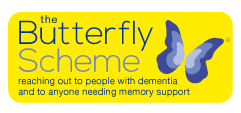We all know that society is edging towards paperless admin, but there’s recently been a worrying trend in hospitals.
Carer documents – like the Butterfly Scheme’s REACH out to ME document, or the Alzheimer’s Society’s This is Me – have in the past decade become established as a valued communication link between the people who know the patient best and those taking up their care in a hospital setting. Even if the patient can’t let hospital staff know what they’re frightened of, what reassures them, what they drink most of, what they enjoy doing and so on, the sheet enables staff to be aware of those things and to pass back on information about changes, or helpful techniques.
That document is often referred to as the Patient and Carer Document; it belongs to the patient and carer. It is therefore not the property of the hospital and isn’t eligible to be digitised as its only mode of access. Yes, a copy can be taken on admission, in case the original goes missing, but that’s only as a back-up.
Anyone who thinks keeping the patient and carer document online-only is going to deliver its benefits is completely misunderstanding its purpose. All staff who meet the patient need access to that document in order to read it, and all of them need access in case they need to update it – because in a hospital environment, people’s behaviours change and techniques need to be found to respond appropriately on an individual basis. Kinship carers, too, may wish to add in or alter those notes as they observe the evolving situation.
There are certain staff who will have online access, in order to read the carer notes – and there are some hospitals who have digitised a version of the document so that it can indeed be updated (by some) along the way – but for the majority of staff and for the kinship carer, if the paper document isn’t by the bedside, it’s no longer a “live” document. In my experience, it’s the housekeeping team who may most influence the mood on a ward – so do they have a handset in order to access a document online?
In addition, simply leaving a paper copy of the document by the bedside isn’t a solution if the hospital’s methodology doesn’t incorporate automatically referring to the document, so there needs to be consistency of use. The Butterfly Scheme teaches that where there is a Butterfly, there will be a patient and carer document – and every member hospital has had to decide where the consistent home of that document is, so that all staff can access it.
Getting the patient and carer document into use as a valuable part of hospital care took a lot of careful work, over a lengthy period – but it got there. However, the post-pandemic move towards paperless systems is threatening to sweep that away and leave people living with dementia less well provided for than before.
Carers, if you find that the hospital you’re linking with isn’t enabling all staff to access the document you’ve provided, by all means show the Dementia Lead this article. The patient and carer document needs to remain just that – a hugely valuable document, supplied by and belonging to the patient and carer – and not to the hospital!
